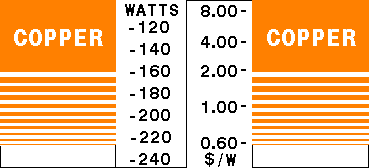Almost all electric utility transformer purchases are "loss evaluated" units.
This purchasing practice has increased significantly in the past 15 years as utilities have become aware of the range of losses at each kVA rating in units currently available and the value of these losses. On the other hand, very few non-utility buyers conduct loss evaluations. Many purchase transformers on a first-cost basis only.
Consideration of transformer efficiency is critical to reducing the load impact on the power producer and to the total owning cost of the purchaser.
Transformer efficiency is influenced by many factors. Primary influences include the choice and quantity of the conductor used in the windings in addition to the quality of the core material. The better the conductor, the lower the heat or I 2R losses. Copper is a more efficient conductor than aluminum; an enlarged cross-sectional area of copper results in lower resistance and, therefore, lower I 2R losses.
Many transformer units have actual conductor watt losses that are three to four times core watt losses. Such conductor losses can range from a low of near 130 watts to 350 watts or more for a 25 kVA unit. Levels ranging above 200 watts are unnecessary and may be costly. Purchasers should be encouraged to examine the actual load and duty cycle of each transformer and the resulting I 2R conductor loss and its impact on their cost of operation before making a purchase.
Loss evaluation can be a complex process. However, as utility companies have learned, this evaluation is an important step in the purchasing process and one that commercial and industrial users could benefit from greatly.
Higher "loss evaluation" values result in more expensive transformer units. However, use of better transformers leads to lower actual watt losses and reduced operating costs. Therefore, life cycle cost evaluations should be expanded to cover all transformer units above about 10 kVA rather than simply comparing "first cost" among units available, as is currently done with many distribution transformers- pole-mounted, pad-mounted or dry-type.
Transformer life for utility units is expected to be 30 to 40 years. Therefore purchasing practices based on loss evaluations and life cycle costs can yield significant savings.
For utility-type transformers, there has been a long-term trend toward designing transformers for increased efficiency of operation (lower losses), based on the increasing costs of wasted energy in the utility grid. This trend has resulted in the use of more metal in a given transformer, and a trend toward more copper since it is inherently more energy efficient.
Copper Coils Mean Lower I 2R Conductor Loss
| USER'S LOSS VALUATIONS | ACTUAL I 2R LOSS (25 kVA Transformer) |
|---|---|
 | |
